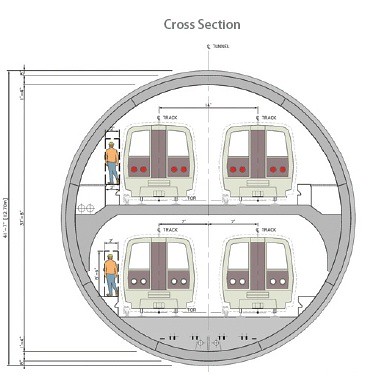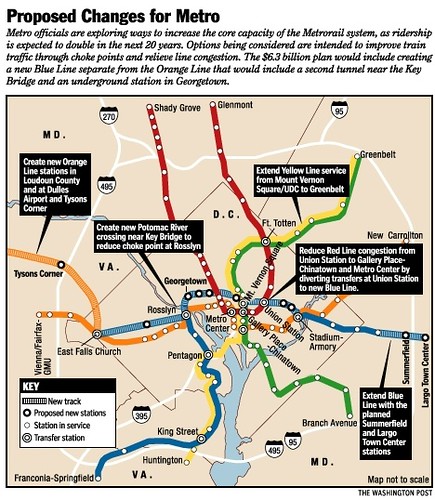Redundancy and good state of repair in transit systems: why a decision made 50 years ago cripples WMATA today
(EE shared with us a link to a Gothamist story about a meltdown on the LIRR today because of a signal system failure, which led to a shutdown of the system and diversion of the passengers to the subway system.)
A couple weeks ago I met with a journalist who is working on a big story about WMATA's meltdown, and today's Post editorial ("Metro focuses on corrections after accidents but fails at preventing them") reminds me of the key point I made at the start of that conversation.
That insight built on these recent posts:
-- "Getting WMATA out of crisis: a continuation of a multi-year problem that keeps getting worse, not better"
-- "http://urbanplacesandspaces.blogspot.com/2015/08/getting-wmata-out-of-crisis.html."
Flickr photo by Barbara Krawcowicz.
WMATA's current problems were engineered into the system from day one (in the late 1960s) because the system was designed without redundancy--it's a two track system without a third (or fourth) track.
We all know how poorly single tracking works in practice. Generally, trains run every 20 to 30 minutes, not every 4-6 minutes.
I don't think it is possible to achieve that level of ridership with a high level of customer satisfaction--which requires a minimum of track and train failures--without redundancy.
I don't understand how that design went forward considering the original projections for ridership exceeded one million riders daily. But it did.
No express service. Lack of additional tracks also prevents the development of express service, and makes track shutdowns for maintenance and repair much more problematic.
No 24-hour service. Additional tracks would also have enabled 24-hour service for the same reason, you can shift service around tracks for maintenance while still operating.
To maintain service without interruption, lack of track redundancy requires that tracks and transit vehicles are always in a state of good repair because even minor track or car breakdowns result in system failures, usually with cascading and increasing negative effects.
It is foreordained that without adequate funding for maintenance and repair the tracks certainly and the signals system possibly will break down.
Plus train cars are expected to be in service for 40-60 years, with regular maintenance. But even with regular maintenance and occasional complete rebuilds, rail cars as they age are more susceptible to break down as well. And of course, some cars are built better than others, and the cars less well built break down more, etc.
Conclusion. In short, irrespective of management failures, WMATA's design and failures to adequately fund maintenance and new equipment purchases to maintain a state of good repair, sets the stage for failure rather than success.
Bonus: A major lost opportunity to build redundancy into the system via the Silver Line project
FWIW, it's unfortunate that the Silver Line was allowed to be built (1) without four tracks; (2) without the requirement to build a second crossing from Rosslyn to DC; and (3) without using it to bootstrap the creation of a separated blue or silver line, something I first wrote about in 2006 ("Blinking on urban design means you limit your chance for success").
Although you can argue the relative lack of density in the Silver Line's catchment area in Virginia doesn't justify multiple tracks, they would be useful for service to Dulles Airport and would be highly useful within the proposed DC section of the Silver Line discussed below.
 Adding tracks at least to that segment, and within the city building a double stack tunnel for a new separated blue line (which I think should be re-termed the Silver Line), would have begun to right the 50-year old design mistake.
Adding tracks at least to that segment, and within the city building a double stack tunnel for a new separated blue line (which I think should be re-termed the Silver Line), would have begun to right the 50-year old design mistake.Also see "Transit redundancy" from 2009.
Multiple tracks and extension into the city would have enabled:
-- express service to and from Fairfax and Loudoun Counties, including to Dulles Airport, which likely would improve that airport's positioning within the region as a place to fly from, which is important given its passenger traffic continues to decline ("Overall passenger decline at Dulles Airport," Loudoun Times)
-- additional throughput capacity between Virginia and DC by adding a second crossing on the north side of the system
-- redundancy in case the current northern tunnel has to close for any reason (for example the signal failures with the LIRR today meant it was unsafe for trains to cross through to Manhattan in the East River Tunnels)
-- expansion of the system without forcing a truncation of service for the current blue line ("Rush Plus still feeling like Rush Minus to Blue Line riders," Washington Examiner
-- an increase in capacity in DC's core--the system is expected to reach capacity in 2025
-- an expansion of areas served within DC, adding Metrorail service to Georgetown, Mount Vernon Triangle, and H Street, with more stations
-- more transit service to Union Station, enabling Amtrak's proposed expansion program to be realized with complementary in-city transit service and adding transit service redundancy (an additional line serving the station) to WMATA's most highly used transit station.

In this Washington Post graphic from 2001, the "Silver Line" is shown as an extension of the Orange Line, and a separated blue line emanates from the East Falls Church station, crosses into DC in a new tunnel, and provides service to Georgetown, service east of the current Downtown alignment of the blue and orange lines, provides service to Union Station via a new transit line, and continues eastward to H Street.
This proposal was junked in 2003, when a short recession impacted WMATA's budget, and WMATA eliminated many of the positions in the construction division and devolved expansion planning responsibilities to the separate jurisdictions.
Labels: civil engineering, risk management and redundancy, transportation infrastructure, transportation planning




5 Comments:
funny how I used to argue these points on blogs and got shot down by all sorts of self appointed "experts" who said we can make do just fine w/o a third or fourth set of tracks. What foolishness. When the silver line was built there idiots had their way all over again. Stupidity rules out transit systems and vehicular cyclists run all cycling planning and decision making we are all forced to have to cope with...
Except for NY, most systems have 2-tracks. WMATAs problem is the lack of switches and crossovers, the ability to operate them reliably and on short notice, must-discussed cultural issues, and the inability to communicate useful information to riders in such a way for riders to make informed decisions on short notice.
I know the issue of switches and interconnections. One of the difficulties of interconnections has to do with the general configuration of the lines. I don't think they can really be interconnected in a way that maintains service given the long distances between the lines and the fact that they serve distinctly different areas. That's not the case with NYC, where there are many lines in close proximity.
Sure, more switches would help, but only at the margins. They wouldn't allow for 24 hour service or express service. They wouldn't provide redundancy in the case of track or train failure.
Plus, yes, NYC is an outlier in North America. Sure, and they will always have 6x the ridership of the system here.
Then you have Montreal. They don't have multiple tracks but the system is entirely underground so it least it is immune to weather incidents.
Then you have a handful of cities, DC, Chicago, Boston, and Philadelphia with ridership greater than 750,000/day.
But Boston and Philadelphia achieve that level of ridership with a mix of modes. WMATA carries more riders on one system.
But unlike traditional transit cities, the WMATA design is both polycentric and a hybrid of commuter rail and subway.
Traditionally, commuter rail covers long distance, subway provides a lot of connections in a smaller geography.
Compare that to the heavy rail systems of CTA or MBTA, which operate on a much tighter geography.
Anyway, I am arguing that a system designed like WMATA needs way more redundancy to be successful.
It's an outlier in how transit systems are normally designed (in terms not just of design but also intended ridership--comparably designed systems like BART and MARTA have significantly lower ridership and always will) and therefore needs a higher level of redundancy than originally believed from an engineering standpoint.
Thanks so much for the site, I found a lot of useful information for us.
Post a Comment
<< Home